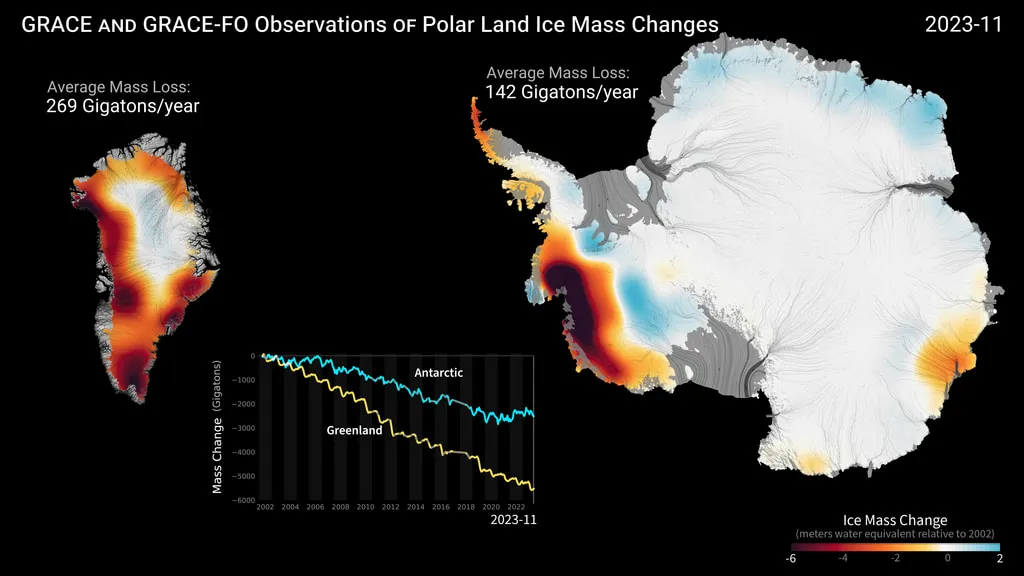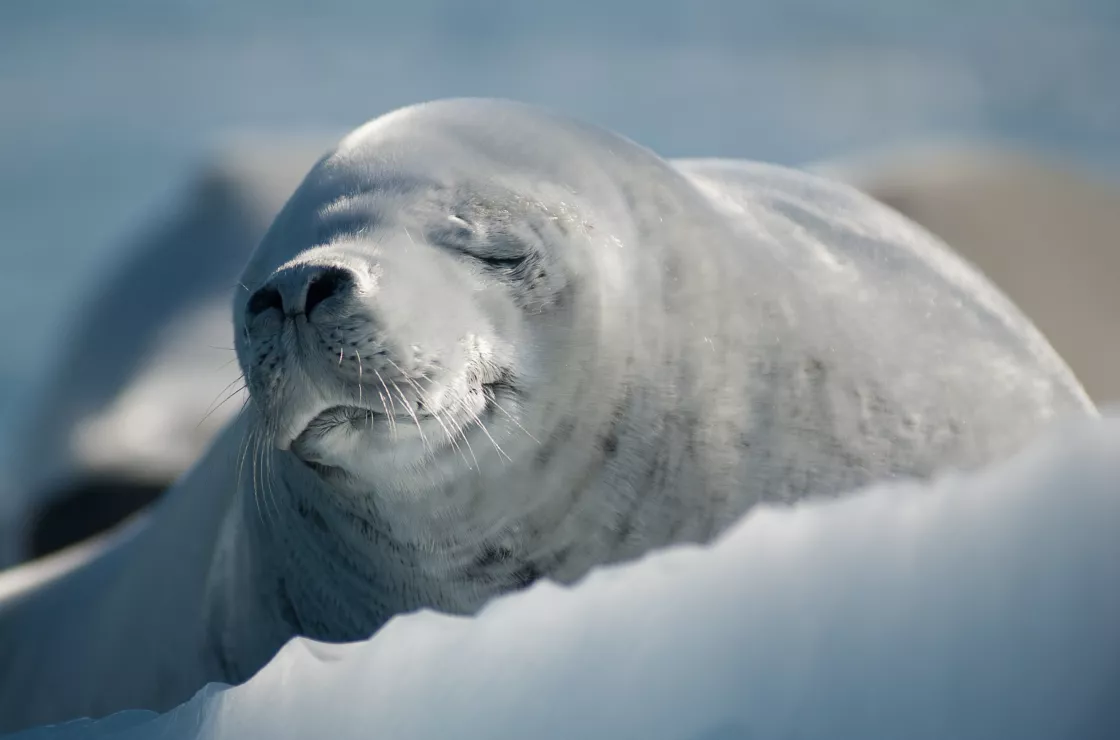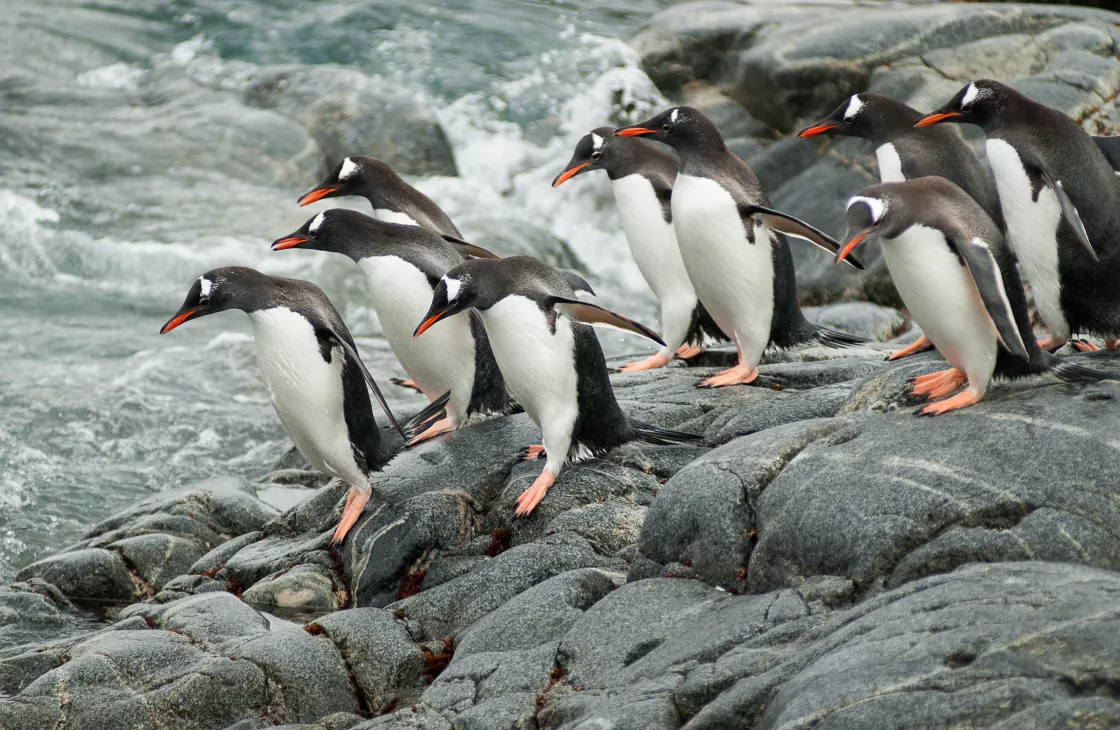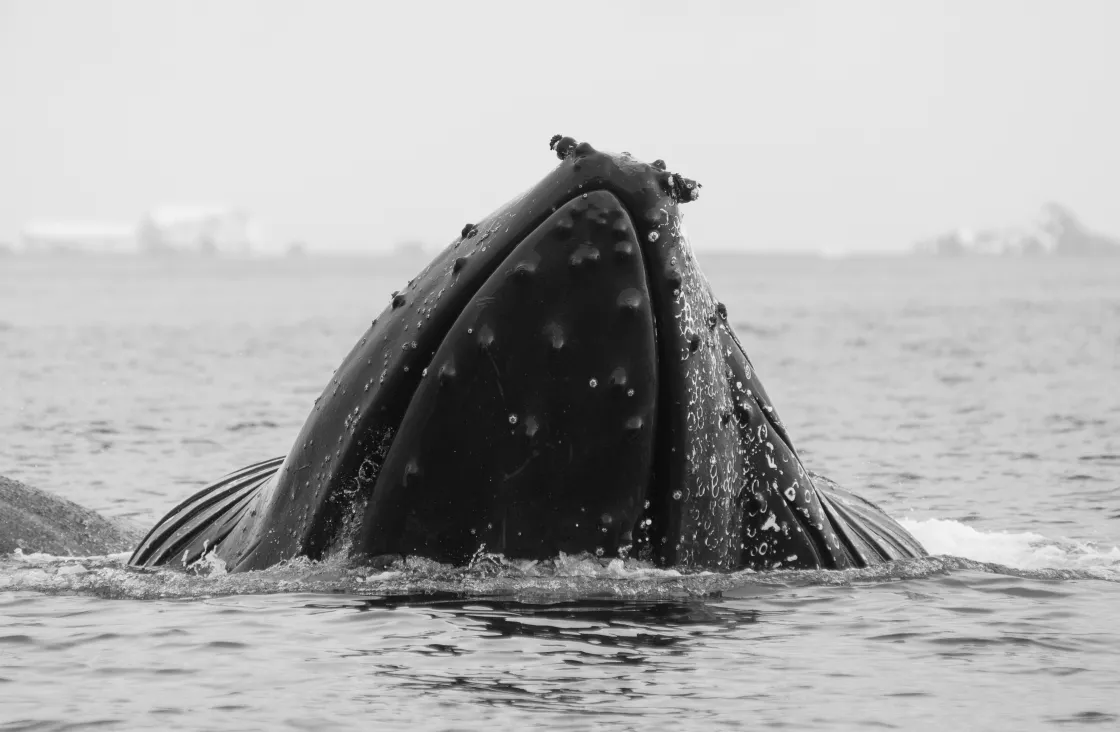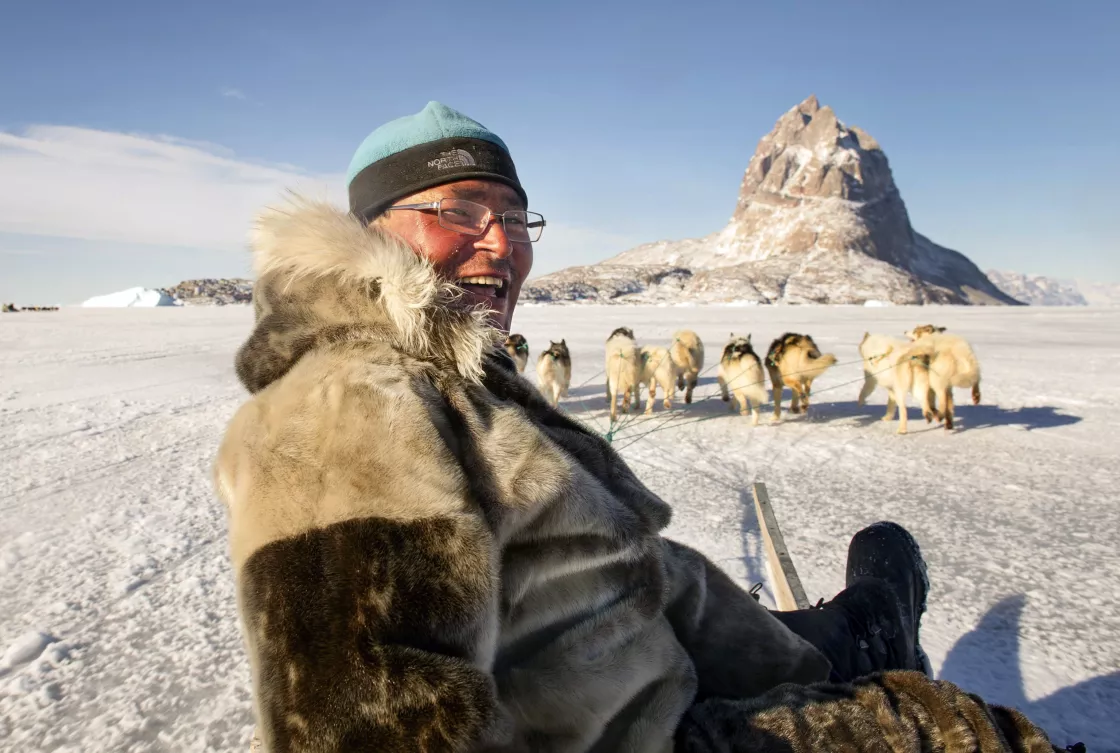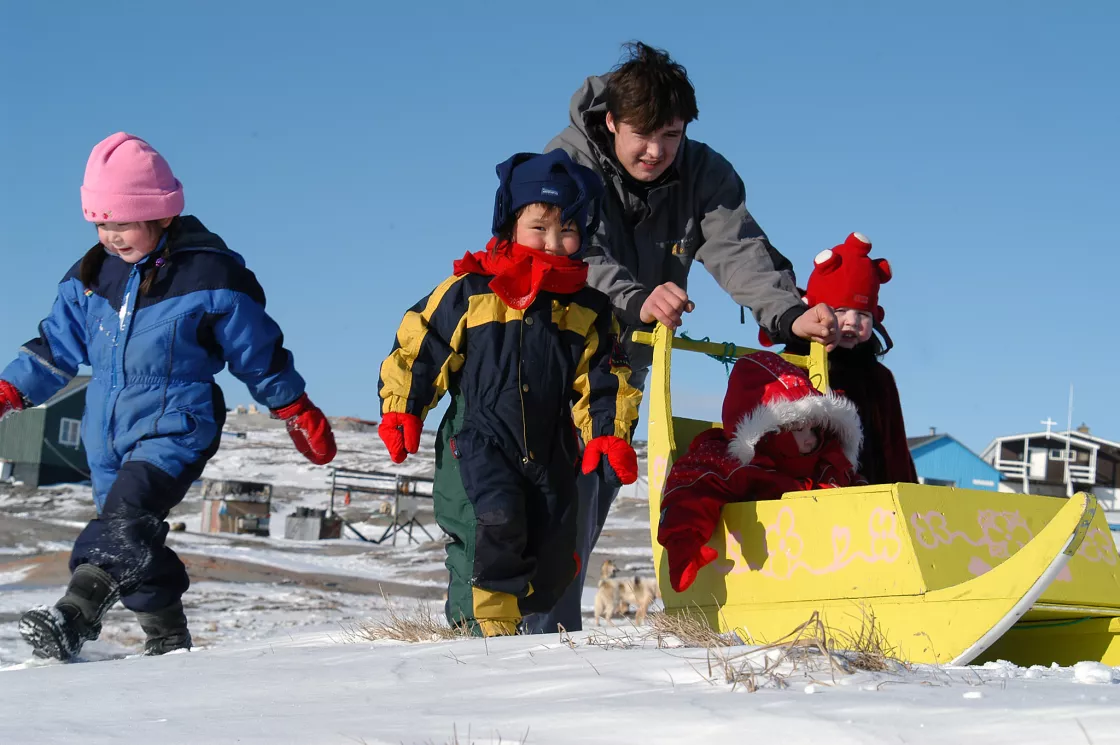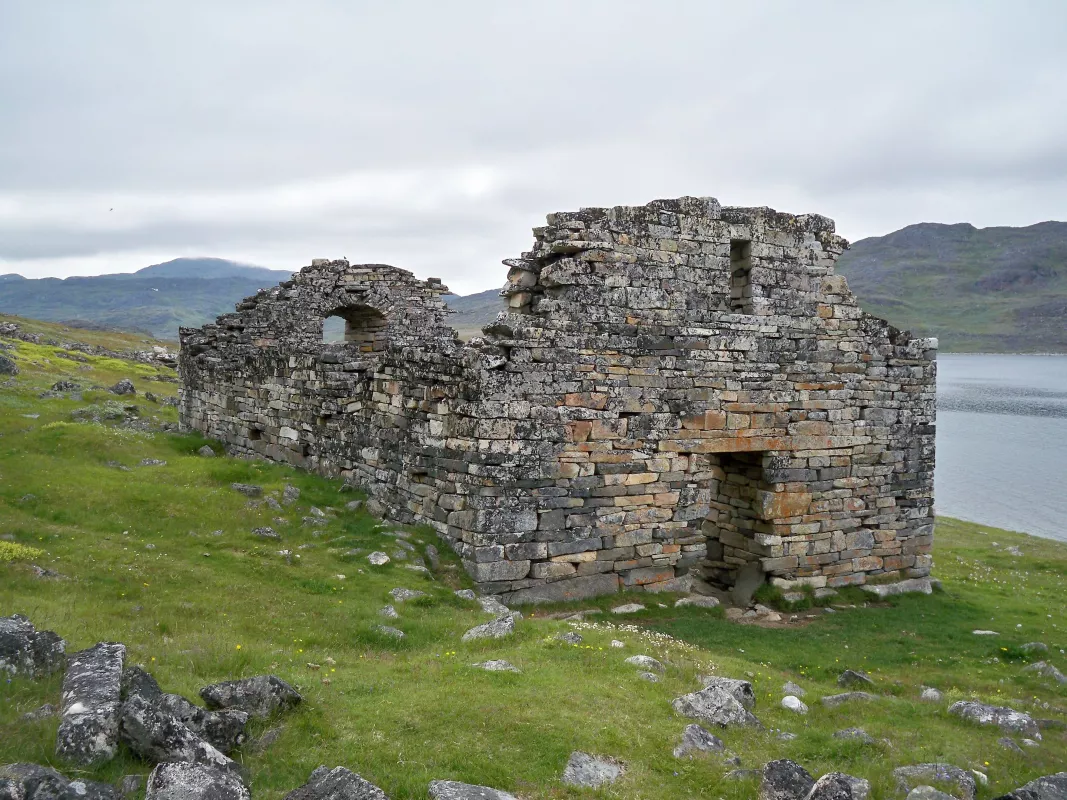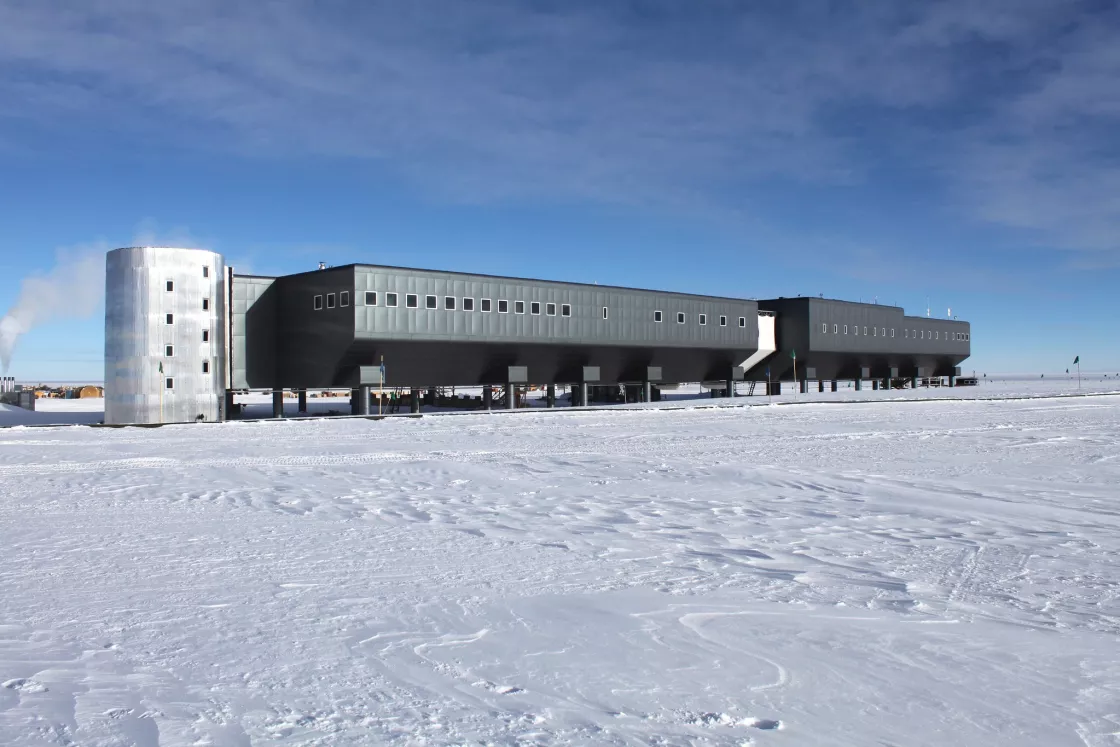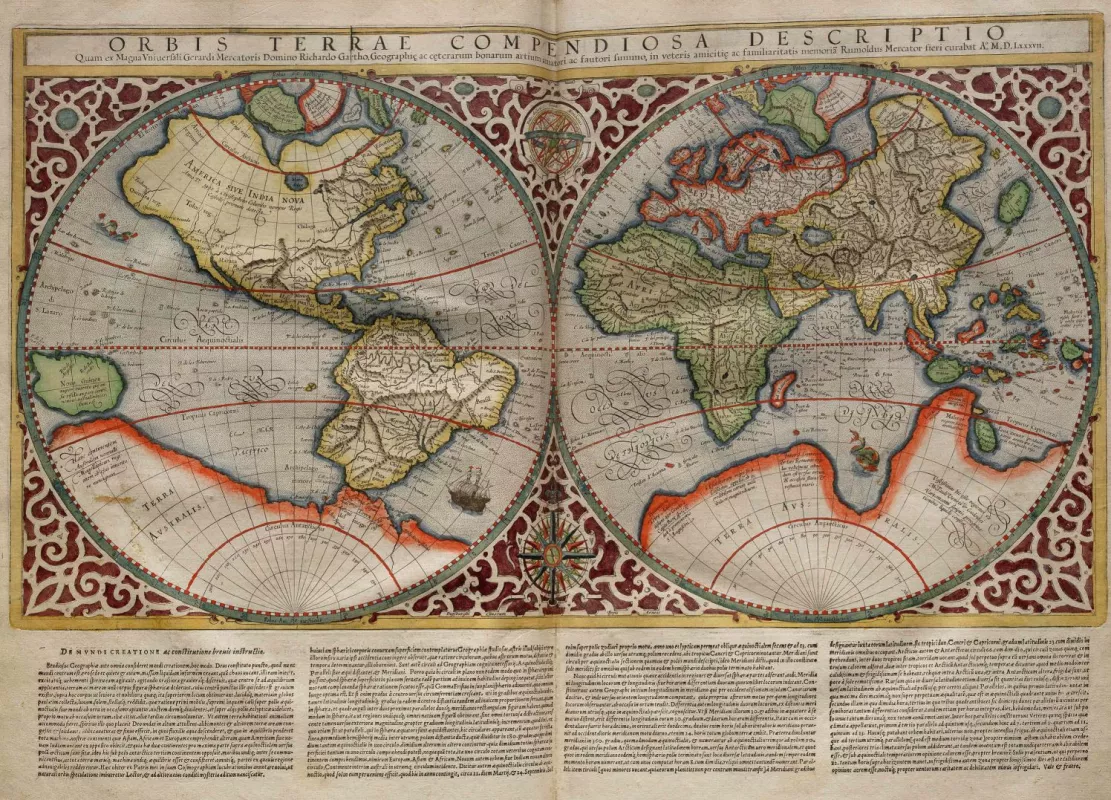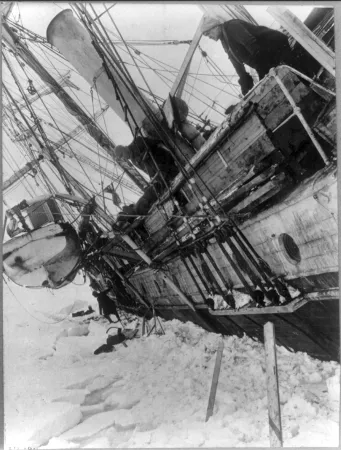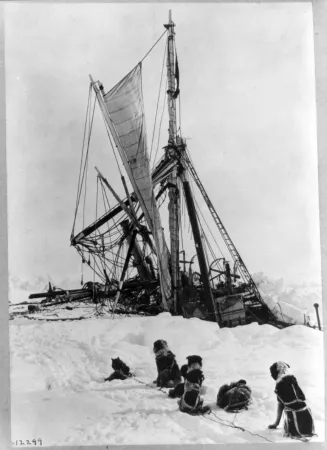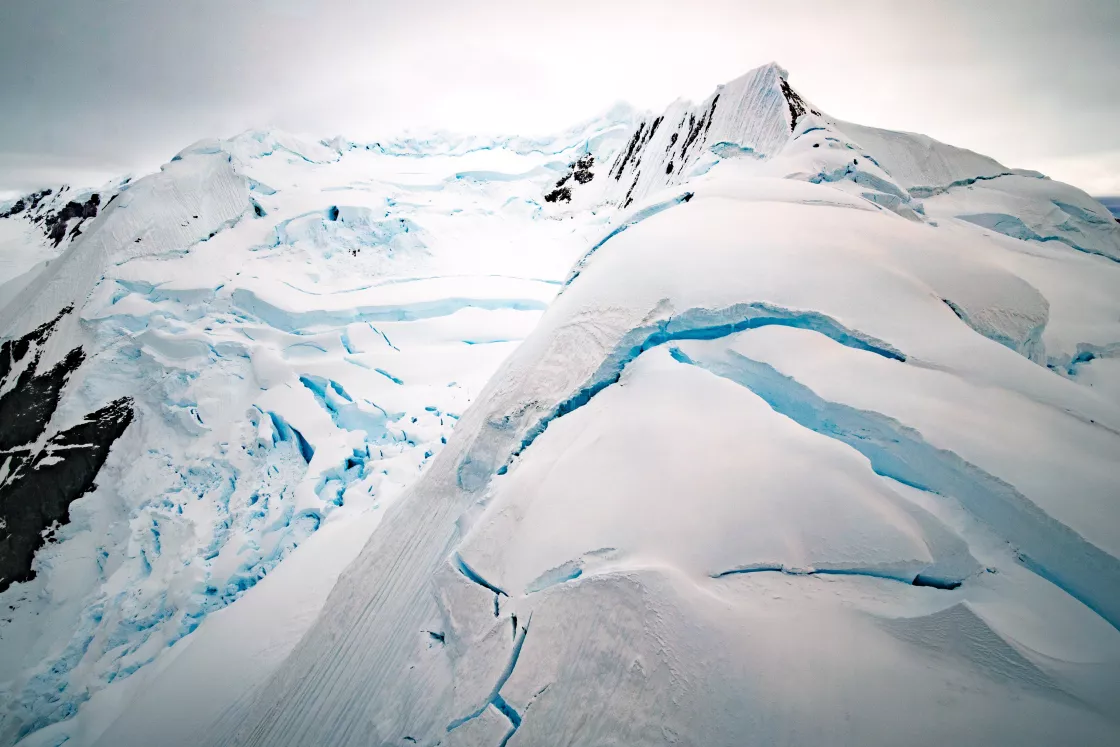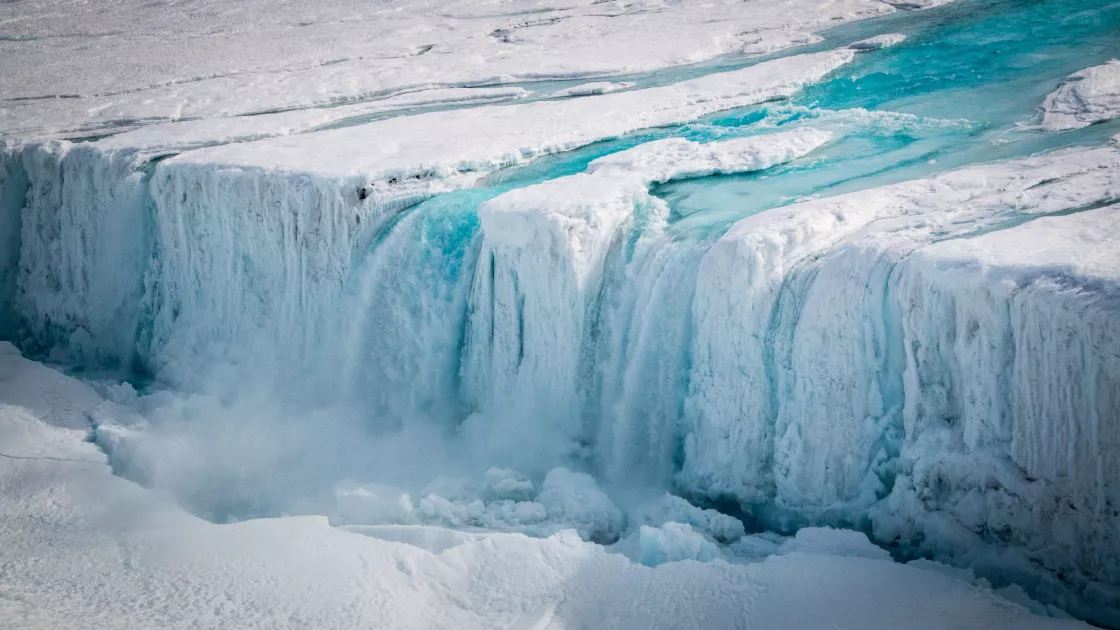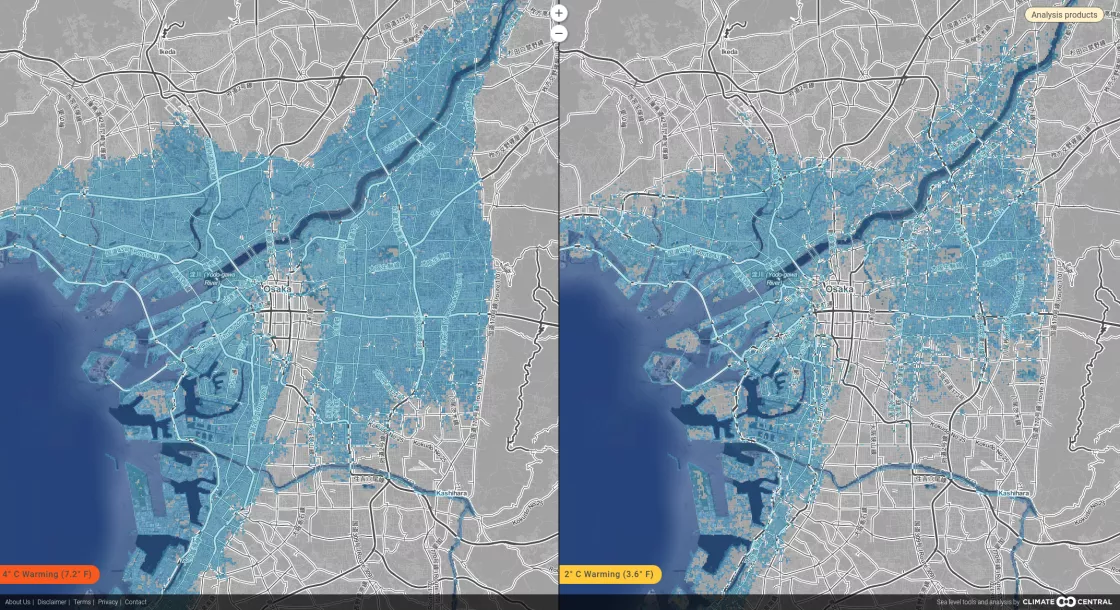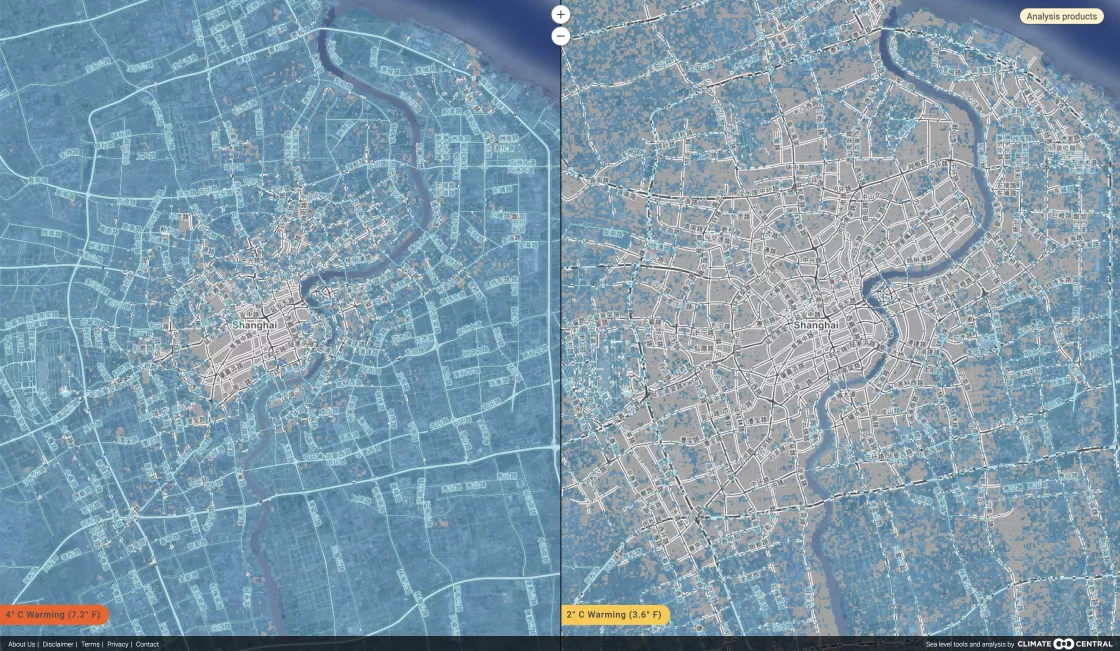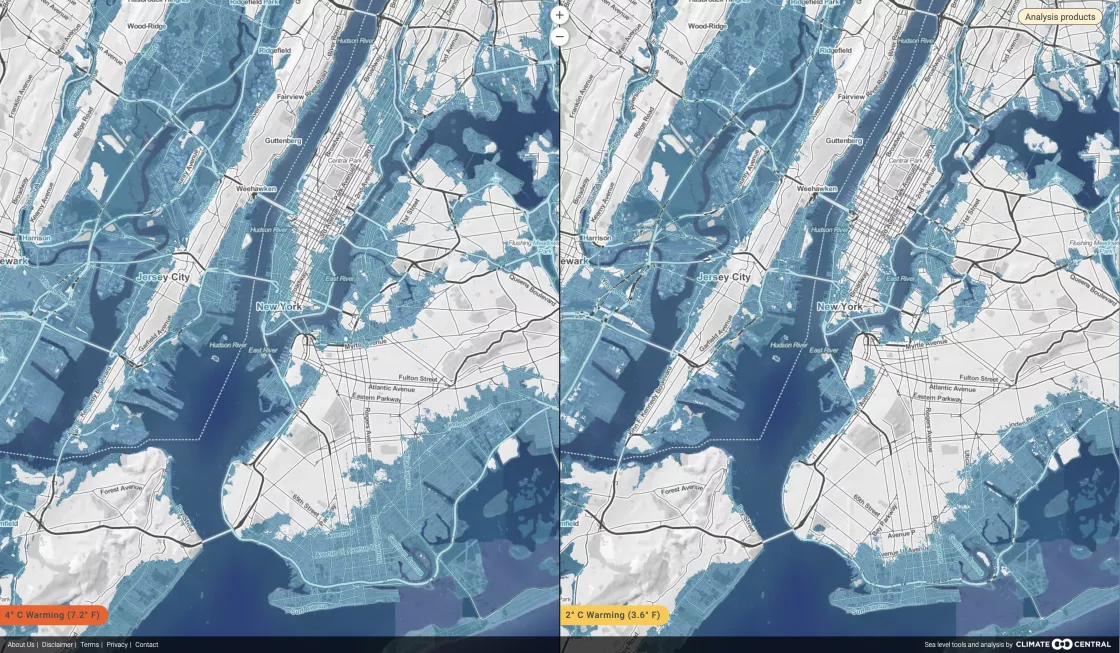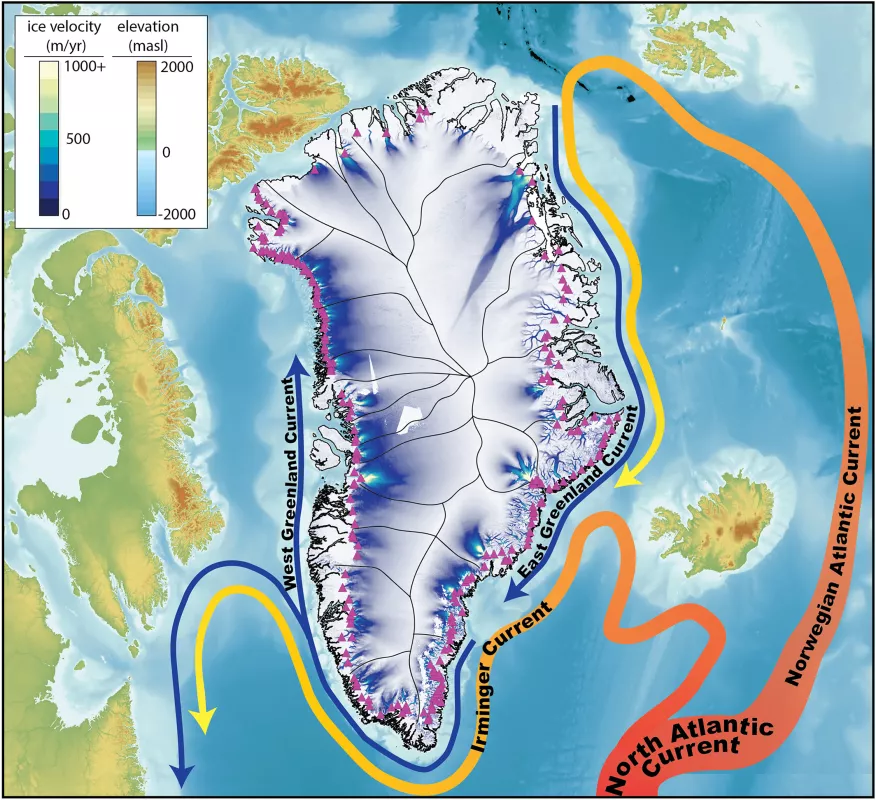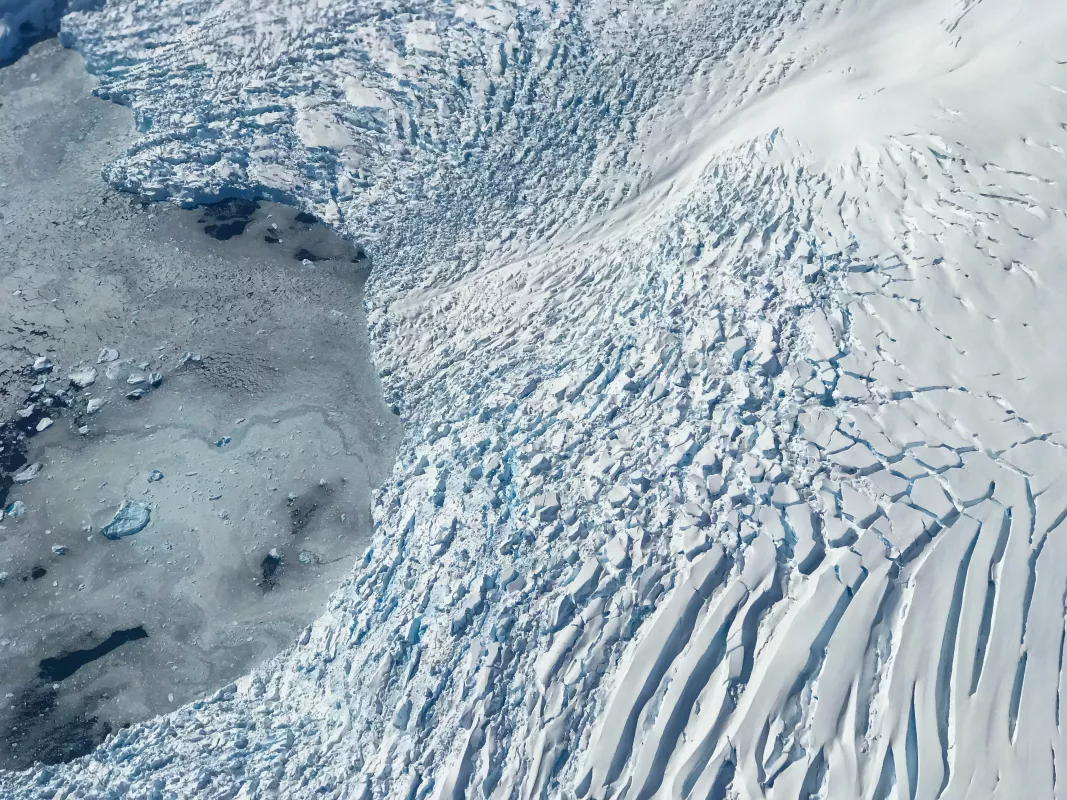Ice Sheets
Why They Matter
Ice sheets contain enormous quantities of frozen water. If the Greenland Ice Sheet melted entirely, scientists estimate that sea level would rise about 7.4 meters (23 feet). If the Antarctic Ice Sheet melted, sea level would rise by about 60 meters (200 feet). While this is unlikely to occur in the near future, there is research to suggest that the entire Greenland Ice Sheet could melt by the year 3000 if the world maintains its current levels of greenhouse gas emissions. In fact, for most of the twentieth century, the ice sheets made very little contribution to sea level, and were nearly in balance in annual snowfall gain and ice or meltwater loss. The stability of the ice sheets has changed considerably in the twenty-first century. According to the 2021 report from the Intergovernmental Panel on Climate Change (IPCC), average sea level across the planet has risen faster since 1900, than over any preceding century in at least the last 3,000 years.
Across the first two decades of the twenty-first century, both ice sheets were shrinking, and the ice loss rates increased with each decade. From 2002 to 2023, Antarctica and Greenland collectively shed enough ice to raise sea level by approximately 1.2 millimeters per year, according to the GRACE and GRACE-FO missions. As a general rule of thumb for every centimeter (10 millimeters) in global sea level rise, another 6 million people are exposed to coastal flooding.
Since ice sheets contain frozen fresh water, when ice sheet melt enters the ocean, it can change the ocean water salinity and temperature and thus density, impacting ocean circulation. Since oceans are constantly evaporating and changing the temperature and humidity of the surrounding air, they are key to regulating climate. Changes in ocean circulation influence local and regional climate, marine wildlife, and the distribution of water within the ocean, which affects local sea level rise.
Ocean currents, gyres, and eddies carry water around the planet, transporting carbon, heat, and nutrients. There are also large-scale, conveyor-belt currents that transport heat from the tropics to the higher latitudes. When warm water flows away from the tropics, cooler atmospheric temperatures lower the ocean surface temperature. As this surface water cools, it becomes denser and heavier and eventually sinks. Slowly, it journeys back toward the equator in the deepest water layers within the ocean. Changes in ice sheet melt can influence these global-scale ocean circulation patterns, such as the Atlantic Meridional Overturning Circulation (AMOC)
The Greenland and Antarctic Ice Sheets also affect winds in the polar regions. Large high-altitude plateaus on the ice sheets alter storm tracks and create cold downslope winds close to the ice surface. Known as katabatic winds, these downslope winds occur when the higher altitudes radiate heat and are cooled. As the air cools, it becomes denser. Gravity does the rest by pulling this denser air downhill. In East Antarctica, where cold, dense air flows down steep slopes, these fierce winds have been estimated to whip downslope as fast as 225 to 249 kilometers per hour (140 to 155 miles per hour), based on measurements at Australia’s Mawson Station in Holme Bay.
In addition to influencing the ocean and atmosphere, ice sheets are important because they contain annual layers that hold a unique and valuable record of Earth's climate history. Pockets of air bubbles locked within the ice can tell scientists what our planet’s climate was like nearly one million years ago.
Ice sheets and wildlife
Though algae lives on ice, ice sheets host few animals. Flora and fauna in Greenland and Antarctica is present primarily at and beyond the ice sheet edges. One way that ice sheets help to support local ecosystems is via freshwater runoff that can be important for transporting nutrients and may play a role in establishing a food chain that supports larger mammals. In Greenland, large mammals like polar bears, seals, and walruses, navigate between the sea ice and shores. On land, musk oxen, caribou, and the white Arctic fox are some of the larger roaming animals. The waters surrounding Greenland are also home to humpback whales and narwhals. Where there is land, there are birds. About 60 species of birds call Greenland home, with another 20 as regular migrants. Among the most striking species is the white-tailed eagle, or nattoralik in Greenlandic. For more information on seals and polar bears, read about sea ice and wildlife.
In Antarctica and, to a lesser extent, Greenland, subglacial lakes are hidden out of sight and light below glaciers. Hundreds, even thousands of meters of ice sit on top of them. Scientists believe about 400 such subglacial lakes are scattered across Antarctica. These lakes may be an important source of nutrients once the waters trickle to the shores. Scientists, who analyzed the water within the lakes, discovered microbes produce carbon-containing molecules essential to start the food chain. Therefore, these lakes may help build a foundation of phytoplankton, bacteria, and zooplankton to support other species like penguins, whales, and seals.
Antarctica has the largest concentration of penguins in the Southern Hemisphere. Other places penguins live include Australia, New Zealand, South America, Africa, and the Galápagos (the only place where penguins live north of the equator). Contrary to popular belief, penguins do not live in the barren South Pole, where temperatures drop to an average of -60 °C (-76 °F) in winter. Instead, they stick to the coast of the Antarctic continent, the Antarctic Peninsula, and nearby islands.
Between 17 and 19 penguin species exist (depending on how they are categorized), nine of which live in Antarctica and its surrounding islands. Penguins are flightless swimming birds, with the ability to dive to great depths. For instance, emperor penguins can dive to over 500 meters (1,640 feet). Shaped to be agile underwater, they use their feet and tail as a rudder, and propel themselves with their flippers. They are also equipped with waterproof feathers, an insulating fat layer, and the ability to drink salt water.
Like the Arctic Ocean, the cold waters surrounding Antarctica are full of life. Penguins feed on small fish and shrimp-like creatures called krill. Their main predators are other marine animals, such as leopard seals, orcas, which live in both polar regions, and birds like the skuas and sheathbills, which eat penguin eggs and chicks.
Ice sheets and people
Greenland
Although an ice sheet covers about 80 percent of Greenland, the world’s largest island has a long history of settlement. Perhaps as early as 5,000 years ago, the Saqqaq culture arrived, followed by the Dorset culture about 2,000 years later. Many modern-day Inuit are thought to be descendants of the Thule culture that came to the country about 1,000 years ago. Today’s Inuit make up a majority of the Greenlandic population, about 50,000 of a total of 56,000 people. Greenland is an autonomous territory within the Danish Realm, with the link going back to when Greenland became a Danish colony in 1721. Greenland secured self-rule in 2009.
Fishing is the primary industry, with Greenland having legislative power over the fisheries sector. As the largest source of income, fishing is a vital component of the economy and people’s livelihoods and subsistence.
The official language of the country is the Inuit language, Kalaallisut; Danish is the second language. Most Greenlanders speak both, and English is also common in bigger towns and among younger generations.
Greenland and the Vikings
Greenland’s walrus population may have also lured the Norse, who were keen on hunting the animal for its ivory tusks. Before Columbus sailed to the Americas, Earth experienced a warm period (from 900 to 1300), allowing the Norse to travel across seas packed with less sea ice. The Norse sailed from Iceland and first settled in Greenland around A.D. 981. They developed pastureland and farms on the western Greenland coast. In 1408, on the southernmost tip of Greenland in fjord Hvalsey, meaning “Whale Island” in Old Norse, a wedding took place. Three letters, written in Iceland decades later, described the event. These are the last written records describing the Norse Greenlanders. After that, they vanished from history.
Europeans returned to Greenland in the early eighteenth century to find the ruins of a Norse civilization. The fate of Greenland’s Vikings has spawned many theories about their collapse, and archaeologists continue the learn more.
In far north Greenland, the growing season is short, and the land is sensitive to overgrazing. The Europeans brought their culture of livestock and farming, but also hunted seals and other marine mammals. Though resilient, the Norse were not self-sufficient and still required supplies. They traded their walrus tusks to the Europeans in exchange for grain, wine, and other essentials.
In 1257, on the other side of the world in Indonesia, the most powerful eruption of the last 7,000 years spread an ashy layer into the atmosphere, blocking the sun and cooling the global climate. Europeans on the mainland experienced a long period of famine. This most likely also impacted the Norse in Greenland. Sea ice spread and colder conditions ensued, making sea travel and hunting particularly dangerous. Yet, that alone was not enough to abolish their culture since records indicate the Norse thrived for at least another hundred years.
Though still debated, a loss of interest in the walrus tusk and a pandemic in Europe and Asia, may have had devastating consequences along with two other global changes. In the thirteenth century, the walrus ivory trade collapsed as Europeans began traveling south, hunting the more valuable elephant tusk. So, the Norse lost their main currency.
Another problem the Norse and Europeans faced was the bubonic plague, which killed more than 20 million Europeans, or one third of the population. There is no evidence the plague reached Greenland, but Norway was a major bloodline for the Norse, and half of Norway’s population had died. What exactly happened to Greenland’s Vikings in their final days is still unclear. A gradual exodus is possible, but there are no clear records to support a concrete explanation. Supporting the exodus theory, however, is the fact that the settlers left very few valuables behind. When you leave, you take your jewelry with you. Still, various theories linger, and a 2023 study pointed to local sea level rise as a factor.
Greenland and the Thule
Meanwhile, the Thule culture arrived at almost the same time as the Norse did, but in Northern Greenland. Thule culture was highly developed and specialized, lasting until the fifteenth century. The Thule, predecessors to modern Inuit, brought technological advancements in hunting techniques and toolsets that allowed them to hunt large marine mammals. They are well known for using slate knives, open skin boats (umiaks), and kayaks. The innovative toggling harpoon, which has a two-part point, could catch, kill, and drag whales to shore. One half of the point is attached to the thrusting base, while the other part sits on top like a cap with an attached sinew or string material. When the harpoon is thrust into the animal, it detaches, twists, and gets lodged under the skin and blubber, preventing it from slipping out and allowing the hunters to haul the animal to ship or shore.
There is evidence of some trade between the Thule and the Norse, but for the most part, the cultures it seems remained separated.
Antarctica: the continent of visitors
Antarctica has no permanent residents, but several thousand people live on Antarctica during parts of the year, supporting scientific research at various stations. In 1959, the United States and 11 other countries signed the Antarctic Treaty, banning military activity in favor of scientific exploration. Several governments have set up permanent research bases that are widely distributed over the continent. Many other stations operate seasonally, totaling over 70 research stations.
McMurdo Station, the logistics hub of the US Antarctic Program, is the largest Antarctic station. Ships resupply the station each year after an icebreaker clears a path through the sea ice. During years when sea ice is thicker and more prevalent, the icebreaker's job is more difficult, time-consuming, and costly.
Other research stations, such as the British Rothera Station, have similar issues of limited access because of sea ice or fast ice, sea ice that adheres to the coastline. For this reason, there are many bases set on King George Island near the northern tip of the Antarctic Peninsula, where the sea ice season is brief. Other bases are set in areas of persistent polynyas, such as Italy’s Mario Zucchelli Station and South Korea’s Jang Bogo Station, set in a large persistent polynya called Terra Nova Bay.
Antarctica: exploration
In the mid-1700s, rumors circulated of a large continent at the South Pole, but because explorers had not yet encountered it, Antarctica's existence was doubted by many. James Cook was an English explorer who led several early expeditions aimed at exploring the landmasses in the far South. In 1772, Cook led an expedition composed of two ships: Cook commanded the HMS Resolution and Tobias Furneaux commanded the HMS Adventure. This expedition was the first to circumnavigate Earth at such a high Southern latitude. They reached as far south as 71 degrees, 10 minutes latitude. However, because of extensive sea ice, the expedition was unable to reach Antarctica, despite several attempts. Upon returning home in 1775, Cook reported that the myth of a continent at the South Pole was nothing more than just that—a myth.
Historians cannot say for sure who saw mainland Antarctica first. Inspired by Cook's southern expeditions, Russian explorer Fabian Gottlieb von Bellingshausen led voyages to further explore the southern oceans and land masses. In 1819, Bellingshausen led a two-ship expedition that was the first since Cook to pass into the Antarctic Circle. Because Bellingshausen's expedition made their southern attempts during the Antarctic summer (November to February), sea ice extent was reduced. On January 28, 1820, the expedition encountered the Antarctic mainland, and Bellingshausen became one of the first people to see the fabled continent. Unfortunately, because of sea ice, the ships were only able to get within 20 miles of Antarctica, and so this expedition could not claim the first landing on Antarctica. But British Royal Navy officer Edward Bransfield and American explorer Nathaniel Palmer might also have sighted Antarctica in 1820. Whoever reached the continent first, early nineteenth-century explorers finally proved that a continent does, in fact, exist at the South Pole.
British explorer Robert Falcon Scott and Norwegian explorer Roald Amundsen both launched expeditions to the South Pole in 1911. Scott's ship landed at McMurdo Sound, and Amundsen's ship landed at the Bay of Whales, which placed his expedition 60 miles closer to the South Pole. After the Antarctic winter lifted, Amundsen's team began its trek to the pole on October 18, 1911, and Amundsen raised the Norwegian flag over the South Pole on December 14, 1911. Scott's party began its trek three weeks later than Amundsen's, and Scott only reached the pole 33 days after Amundsen had arrived. Scott's party experienced more than disappointment at losing the race. Scott and two of his team members died trying to return to their ship. His last diary entry was dated March 29, 1912.
In retrospect, historians have found that Scott made a series of errors, such as relying on tractors with caterpillar treads without adequately testing them beforehand. He also miscalculated about weather conditions, time on the ice, and the health and nutrition of his team members.
Sea ice, which complicated Bellingshausen's efforts nearly a century earlier, played a key role in the British expedition of 1914 to Antarctica, led by Ernest Shackleton. The goal of the Shackleton expedition was to cross the entire Antarctic continent from the Weddell Sea to the Ross Sea.
Shackleton's ship, the Endurance, sailed into the Weddell Sea in 1914 with a crew of 28 men, several dogs, and one cat—Mrs. Chippy (who was actually male). They encountered more sea ice than expected, and the Endurance became trapped in the ice on January 18, 1915. For several months, the ship drifted with the ice until it was finally crushed by the ice. The crew abandoned the ship on October 27, 1915, and began walking across the ice, pulling three lifeboats along. They kept the dogs to help pull the lifeboats, but Mrs. Chippy had to be killed after they abandoned the ship because the crew could take with them only what was absolutely necessary.
The crew found that crossing the ice was impossible, even with the help of their dogs. The ice was full of ridges (piles of ice) that they had to climb over, and the wet snow was sticky, making it even more difficult to drag the lifeboats. After a couple of attempts to cross the ice, the crew built a small camp on the ice and waited for the drift of the ice to carry them northward. They killed the dogs because their food supply was limited, and they could not spare extra for the dogs. Additionally, the dogs themselves provided extra meat for the crew, who did not know how long they would be stranded at their camp.
On April 9, 1916, after 164 days of drifting on the sea ice, the ice floe they were camped on finally reached the ice edge and began to break up. They boarded their three small lifeboats and sailed through rough seas, with little food or water, for seven days. Eventually, they reached the small, uninhabited Elephant Island near the northern tip of the Antarctic Peninsula. For the first time in 497 days, the men stood on real ground. However, the island was small, unsheltered, and far from any sailing routes. The chance of being rescued by a passing ship was minimal. No outsiders knew where they were, or even that they were in trouble.
Shackleton decided that the only hope of saving his crew was for a small group to attempt to sail to South Georgia Island, which had a whaling station and a ship that could come back and rescue the rest of the crew on Elephant Island. South Georgia Island is 1,287 kilometers (800 miles) to the east of Elephant Island, across some of the roughest seas in the world. Shackleton hoped to do it with rudimentary navigational equipment in the James Caird; at 6.7 meters (22 feet), it was the largest of the lifeboats. After 14 days of sailing, the crew ran out of fresh water. Fortunately, on the verge of dehydration, they reached South Georgia Island two days later. After a 36-hour hike across a steep and snowy mountain range, they reached the whaling station on May 20, 1916. This was their first encounter with civilization in 531 days.
Shackleton could not rest for long at the whaling station. He needed to return to Elephant Island and save the rest of his crew. Even though he left immediately, it took three attempts and more than three months to rescue the crew because sea ice prevented the ships from reaching the island. Finally, on August 30, 1916, the rescue ship made it to Elephant Island. Amazingly, after 143 days on Elephant Island, 307 days since abandoning the Endurance, and almost two years after the beginning of the expedition, not a single person in the expedition perished.
A little-known part of this story involves the Aurora, which sailed to the other side of the Antarctic continent to haul supplies for Shackleton's planned trek across the continent. The Aurora crew also encountered harsh conditions, and three crew members were killed when they left the ship. They unwisely ventured onto unstable sea ice. A blizzard appeared, and they were never heard from again.
Ice sheets and the environment
The Greenland and Antarctic Ice Sheets have key geographic and environmental differences. Greenland is the world’s biggest island, located close to Canada, with narrow passages between the two countries. Antarctica, by contrast, is a remote and massive continent. The vast open Southern Ocean surrounds Antarctica, which is also known as one of the coldest, windiest, and driest places on Earth.
Part of ice sheet stability is a delicate balance of air and ocean temperatures and precipitation. With Arctic amplification, the Arctic is warming more than twice as fast as the rest of the world. With two-thirds of Greenland lying within the Arctic Circle, it is exposed to these more rapidly rising temperatures. Warmer air temperatures help the atmosphere hold additional moisture, and this can produce more precipitation. Measurements from 2002 to 2020, indicate that there has been some thickening (gains in snow) in the ice sheet interior. However, ice loss around the entire periphery has increased, and ice loss is substantially outpacing ice gain.
The Antarctic Peninsula, a swirly tail of land with a mountain range that continues from the Southern Andes, is also one of the fastest warming places on Earth. Between 1950 and 2023—the year the Intergovernmental Panel on Climate Change (IPCC) released its Sixth Assessment Report (AR6)—air temperature on the Antarctic Peninsula rose by 3 °C (5.4 °F), a rate that is five times faster than the global average reported by the IPCC AR6 over the same period. Since Antarctica is a massive continent, climate change is not impacting other parts to the same extent as the peninsula or Arctic, though impacts from climate change are now observable everywhere in Antarctic—and on Earth.
Much like sea ice and snow, ice sheets play an important role in reflecting solar energy, helping to cool our planet. However, changes to the ice or snow surface are underway and overall the ice sheet surfaces are darkening. Some changes can occur because of increased ash from wildfires, increased dust from disrupted soils caused by agriculture and construction, and algae blooms on ice. For the ice sheets, surface darkening also occurs through ice grain size changes and by exposing older ice surfaces as the winter’s snow melts away. The darkening surface can create a vicious amplifying cycle in which the darker surface absorbs more solar energy (heat), causing further melt and darkening.
Impacts of climate change on ice sheets
Changing the furniture layout in your home changes how you move through it. In much the same vein, changing the composition of our oceans—their temperature and salinity levels—changes how water moves around the globe. Between 1992 and 2020, an international team found, the Greenland and Antarctic Ice Sheets contributed 21.0±1.9 millimeters to global mean sea level. An influx of very cold fresh water to the oceans affects how the currents move through the oceans. The oceans, in turn, feed the atmosphere, which influences air temperatures, humidity and precipitation, and winds. Earth is a closed system where materials cycle between the lithosphere (Earth), atmosphere, hydrosphere, and biosphere: changes to one part of the system influence another. Consequently, changes to any part of Earth’s frozen system—the cryosphere—regions have global consequences.
A losing balance: ice sheet mass balance
Both the Greenland Ice Sheet and Antarctic Ice Sheet have experienced substantial ice loss in the twenty-first century. According to a 2020 article in Nature, the Greenland Ice Sheet is the “largest single contributor to rising sea levels.” Up to the 1980s, the Greenland Ice Sheet had mostly been in balance. However, by the late1990s, Greenland began losing substantial amounts of ice.
The mass balance of an ice sheet is the difference between its total snow input and the total loss through melting, ablation, or iceberg calving. Melting can occur on the surface, at the interface between the ice sheet and land beneath it (a phenomenon related to pressure melting), or when coastal ice comes in contact with warmer ocean waters. Ablation is the direct evaporation of the ice, changing ice into atmospheric water vapor. Calving occurs when chunks of ice break off into the ocean. So long as an ice sheet gains an equal mass through snowfall as it loses through melt, ablation, and calving, it is said to be in balance.
In 2019, researchers reported in the journal Proceedings of the National Academy of Sciences that the Greenland Ice Sheet is losing ice four times faster than it was in 2003, with a significant portion of ice melt concentrating in southwest Greenland. From 1985 to 2020, the ice sheet lost 4,200 gigatons (4.2 trillion tons) of ice, which is equivalent to adding the water from 46.7 million Olympic-size swimming pools to the ocean every year for 36 years.
Findings from a 2020 study show that Greenland set a new record for ice loss in 2019. The ice sheet shed the most mass since at least 1948, losing about 532 billion tons of ice, reversing the more moderate ice loss rate observed in 2017 and 2018. Those two years were relatively mild after a decade of larger losses. At higher elevations, an increase in winter snow accumulation can partially offset the ice loss. However, ice loss continues to outpace accumulation because warmer temperatures have led to increased melt and faster glacier movement at the island's edges has also increased ice loss.
Because ice sheets contain so much ice and have the potential to raise or lower global sea level so dramatically, measuring the mass balance of the ice sheets and tracking any mass balance changes and their causes is very important for forecasting sea level rise. Scientists monitor ice sheet mass balance through a variety of techniques. Learn more information on various research approaches and techniques.
Surface melting impact on ice sheets
Surface melt on an ice sheet not only directly reduces the ice sheet mass, but also can influence ice flow and even lead to further melting. Surface meltwater can penetrate cracks in the surface, and force them open, allowing large amounts of water to drain to the bed and influence how the ice sheet moves.
In February and March 2002, the Larsen B Ice Shelf on the Antarctic Peninsula underwent rapid disintegration. Warm summertime temperatures led to the formation of melt ponds on the ice surface. Some of this meltwater infiltrated cracks in the ice, slicing through the shelf. The increased amount of fracturing, and possibly changes at the ice shelf margins (loss of connection with the coastline) and wave action (flexing the shelf a slight amount), led to the break-up of the shelf. Similar events have occurred before (Larsen A Ice Shelf in 1995, Larsen Inlet Ice Shelf in 1986 or 1987) and since (northwestern Wilkins Ice Shelf in 2008), but so far, these events are limited to the Antarctic Peninsula. The Peninsula is the fastest-warming part of the Antarctic continent.
Ice shelves help to hold back and slow the flow of the land-based glaciers upstream, but once an ice shelf disintegrates, the glaciers can accelerate. Since glaciers are sitting on land, moving more ice from the glacier out to the ice shelf or the ocean adds mass to the ocean, raising sea levels. A 2004 study concluded that in the year and a half following the 2002 Larsen B disintegration, the glaciers feeding the Larsen Ice Shelf accelerated substantially, some of them moving several times their previous speed. Glacier flow speeds subsequently dropped but remained quite high compared to what they had been before the ice shelf breakup. While the Larsen B glacier system is of only moderate size (about 10 gigatons ice loss per year), even small additions of water to the ocean can add up, and the process is an example of what might occur on a larger scale. For more information on the Larsen Ice Shelf Disintegration, read What happened to the Larsen Ice Shelf?
Similar patterns of ice calving and retreat leading to enhanced glacier acceleration have also been observed in Greenland. In southeast Greenland, for example, two large glaciers named Helheim and Kangerdlugssuaq lost parts of their floating ice tongues in 2003. Based on a 2007 study, the glaciers then underwent a rapid acceleration, undergoing changes at approximately three times their earlier speed. These glaciers have gradually slowed in the following years, though their speeds and the locations at which they terminate in the ocean continues to vary. Calving and mass loss from other glaciers around the Greenland Ice Sheet periphery also continues.
Sea level rise from ice sheets
In the United States, almost 40 percent of the population lives near the coast. Sea level rise does not just contribute to flooding, but can also cause shoreline erosion, bigger storm surges, problems with coastal infrastructure including sewage and drinking water systems, and contamination of freshwater aquifers. Globally, eight of the world’s ten largest cities are near a coast, according to the United Nations Atlas of the Oceans. The regional impact of these changes is highly uneven, with four out of five people affected living in Asia.
Global sea level rise is caused primarily by a combination of meltwater from glaciers, including ice sheets, and thermal expansion of sea water as the ocean warms. (Ocean water takes up more volume as it warms.) Antarctica and Greenland, the world's two ice sheets, make up the vast majority of Earth's land ice. If these ice sheets melted entirely, sea level would rise by more than 65 meters (210 feet). These ice sheets are currently out of balance, with more mass leaving the ice sheet than is replaced by snowfall, especially in West Antarctica and Greenland. According to the 2021 IPCC Report, the planet has already entered a phase of irreversible sea level rise for thousands of years to come. However, the rate of sea level rise is particularly important for determining how well communities will adapt, and that rate is still heavily dependent upon the human response to climate change.
Even small amounts of melt impact sea level rise and coastal communities. Some low-lying Pacific Islands are already becoming flooded. Tuvalu, an independent island nation within the British Commonwealth, lies in the Pacific Ocean midway between Hawaii and Australia. Two of its nine islands are on the verge of going under, swallowed by disappearing sand beaches and sea level rise. Florida is one of the most vulnerable states in the United States. In Miami-Dade County, saltwater intrusion is contaminating drinking water and jeopardizing sewage plants. According to a non-profit that uses NOAA data to show flood risks under climate change, approximately 3,000,000 properties are already at risk in Florida, and within 30 years, another 500,000 will be at risk for frequent flooding in Florida. A 2021 NASA study projects more frequent flooding in the 2030s, as the moon's wobble exacerbates climate change effects.
Further destabilization of Antarctic and Greenland Ice Sheets will have catastrophic effects with irreversible effects on wildlife and communities, and contributions to sea level rise from these ice sheets will ultimately dwarfing contributions from mountain glacier losses. A 2021 study shows that if current emissions are not cut dramatically, Antarctic ice melt may accelerate around 2060, nearly doubling its contribution to sea level rise by 2100. In some areas of Antarctic, irreversible ice loss is likely underway, but the rate of that ice loss still depends on the amount of global warming caused y people.
Sea level rise is not uniform. Individual locations experience different changes in sea level because of local factors. The strength of winds and ocean currents causes natural variability and influences how much and where heat is stored in the deeper layers of the ocean. A significant factor in many areas also involves ice that melted long ago. A glacier or ice sheet exerts pressure on the land directly underneath it, pushing it down, while pushing adjacent land areas up, the same way gently pressing one part of a balloon will cause another part of that balloon to bulge. Remove your hand, and the balloon will revert to its old shape. Some areas, such as Juneau, Alaska, are actually rising because they are still adjusting to the retreat of glaciers after the Little Ice Age, which lasted from the early fourteenth century through the mid-nineteenth century. Multiple locations along the US East Coast, however, are slowly sinking because of the retreat of the Laurentide Ice Sheet, which previously exerted pressure on land to the north. Local lands may also rise or lower due to changes in groundwater. These local factors—vertical land motion, ocean currents, wind patterns, proximity to ice melt, and so on—are critical variables for understanding and projecting local changes in sea level.
Going forward, ice loss in Greenland and Antarctica will have varying effects on Earth's oceans. One way loss of ice from the ice sheets will affect the ocean is by changing the ice sheet pull on the nearby ocean. The ice sheet itself has mass that exerts a gravitational force on the surrounding ocean. A loss of mass from the ice sheet causes nearby ocean levels to fall as the mass and gravity of the ice sheet decreases. However, the sea level in areas far from the ice sheet rises. Consequently, ice sheet contribution to sea level rise—even if it were the same amount—would have different impacts, depending on whether the contribution came from Greenland or Antarctica. Broadly, ice sheet mass loss causes the sea level nearby to drop but causes sea levels far away to rise.
Between 1880 and 2022, average sea level rose 21 to 24 centimeters (8 to 9 inches) globally, with about 8 centimeters (3 inches) occurring since 1993. In 2019, average sea level was 87.6 millimeters (3.4 inches) above the 1993 average. How much ice sheets will continue to contribute to sea level rise in the coming decades and centuries will depend in large part on human activity. In 2017, National Ocean and Atmospheric Administration (NOAA) scientists estimated global sea level rise by 2100—from all sources, not just ice-sheet melt to be at least 0.3 meters (12 inches) under a low emission scenario; 0.5 meters (1.6 feet) under an intermediate-low scenario; 1.0 meter (3.3 feet) under an intermediate scenario; 1.5 meters (4.9 feet) under an intermediate-high scenario; 2.0 meters (6.6 feet) under a high scenario to an extreme emission scenario of 2.5 meters (8.2 feet).
Although thermal expansion of ocean water itself has been projected to contribute the most to sea level rise, the potential of large contributions from the Antarctic or Greenland Ice Sheets may cause sea levels to rise much more. Scientists have provided valuable projections of future ice sheet mass loss, depending on the decisions that humans make about greenhouse gas emissions. Some processes for ice sheet change, however, are difficult to observe and predict. This means that scientists' projections of future ice loss encompass a range of possible values. One area of active study involves investigating changes in ice shelves, the thick extensions of glaciers that float on the ocean, and their influence on ice sheet loss and sea level rise.
Various processes involving ice shelves could unfold. One process known as hydrofracturing occurs where surface water slices through the ice because of its higher density. Another process called marine ice cliff instability arises from the relative weakness of ice. Ice cliffs more than about 90 meters (295 feet) tall are inherently unstable. Incorporating these processes in some models leads to higher projections of global average sea level rise by the year 2100: 0.26 to 0.98 meters under a low emission scenario, and 0.93 to 2.43 meters under a high emission scenario. The higher emission scenario shows a much greater ice sheet contribution to sea level rise.
Ice loss from the Antarctic and Greenland Ice Sheets continues to be a critical and quickly evolving area of research. A 2021 study published in Nature states that if the world continues on its current emissions path, exceeding 2° Celsius (3.6° Fahrenheit), Antarctica might experience a jolt in ice melt and loss around 2060, doubling its contribution to sea level rise by 2100. These numbers may continue to be adjusted as new research about ice loss processes emerges.
All these studies, however, underscore an important point: Being far away from a melting ice sheet is no source of safety. In fact, the opposite is true. Because of changes in Earth's gravity field resulting from ice sheet mass loss, ocean sea level may drop near the areas of melt and rise elsewhere. Miami, Tokyo, Shanghai, and Los Angeles are just a few of the coastal cities that experience higher sea levels caused by faraway ice-sheet melt.
A sensitive ocean circulation
The ocean covers over 70 percent of Earth’s surface and supports the greatest biodiversity on the planet. The ocean plays a major role in the global carbon cycle, holding up to 54 times more carbon than the atmosphere. It regulates the transfer of global heat and drives climate and weather.
The Atlantic Meridional Overturning Circulation (AMOC) is a large system of currents that carries warm, salty water north in the upper layers of the ocean, and cold water south in the deep ocean. This ocean circulation system transports substantial amounts of heat from the tropics to the Northern Hemisphere, where it enters the atmosphere. Scientists say that the AMOC is now “in its weakest state in over a millennium.” Since the AMOC has a moderating effect on Europe’s climate, a weaker AMOC could lead to hotter summers and colder winters in Europe. Likewise, the US East Coast may experience additional sea level rise as currents and wind patterns shift in response to the change.
Amassed research acknowledges the weakening of the large-scale AMOC that transports heat from the tropics to the North Atlantic, bringing more moderate climate conditions to Europe. The mechanisms behind the trigger are complex. The additional fresh water entering the ocean from increases in Greenland ice loss is one contributor to the changing AMOC because additional fresh water makes it more difficult to form dense, cold, salty waters that sink from the ocean surface to the bottom. The fresh water from the Greenland Ice Sheet also contributes to creating a surface water cap that is less Salty and less dense. This cap blankets the AMOC current and prevents it from cooling and sinking. It also prevents it from warming the air above it, blocking the warmth that keeps the climate of London and Paris much milder than cities such as Montreal or Minneapolis, which are at the same latitude.
Changes in sea ice formation also influence the AMOC. Sea ice that is two or more years old often loses all the salt it initially contained. This process, known as brine drainage, removes salt from the ice slowly over time, making sea ice a source of fresh water when it later melts. For more on this process, read about sea ice properties.
Ocean impacts on ice shelves, and by association ice sheets
Ocean water drives a significant portion of ice loss for the Antarctic Ice Sheet, where surface temperatures are still too cold to create much surface melting. Thus, in contrast to Greenland, surface melting affects only a tiny proportion of the mass loss from the Antarctic Ice Sheet.
Summertime melt occurs primarily along the Antarctic Peninsula and the northernmost fringes of East Antarctica, and predominantly on the surface of ice shelves around the ice sheet edges. Ice shelves are giant tongues of ice that float on the ocean, extending from land. They border about 75 percent of the Antarctic Ice Sheet.
When ice shelves shrink or collapse, they no longer hold the massive ice sheet’s glaciers in place. Without these stoppers holding back glacial flow, the ice flows more freely into the ocean, raising sea levels. A study published in 2020 analyzed satellite data from 1994 to 2018, finding that Antarctica’s ice shelves have lost nearly 4 trillion metric tons of ice since the mid-1990s. From 1979 to 2017, the mass balance in Antarctica shows a decline for the entire period, with a ramping up in the 2000s for coasts most exposed to the warm circumpolar deep water. The Amundsen and Ross Seas appear to have the strongest impact in terms of higher temperatures as these warmer ocean waters move in, but there is evidence of subglacial melt from warming ocean waters in both East and West Antarctica.
Multiple studies of Antarctica indicate growing ice sheet instability, especially in the Amundsen Sea Embayment, where the Thwaites, Pine Island, Smith, Kohler, Pope, and Haynes Glaciers drain the central West Antarctic Ice Sheet. The Thwaites and Pine Island Glaciers are the so-called weak underbelly of the West Antarctic Ice Sheet.
Part of the issue is related to Antarctica’s topography. The Transantarctic Mountains divide Antarctica into two main sections: West and East. West Antarctica is grounded beneath sea level; meaning, if all the ice melted, the landscape underneath would be underwater. East Antarctica, the larger section of the ice sheet, has several plains and mountain ranges below the ice, but mostly above sea level. In Antarctica, a compilation called Bedmap2, produced by the British Antarctic Survey, merges multiple data sources to map the seafloor and sub-glacial bedrock elevation. (The Greenland equivalent is BedMachine v3.)
In 1981, the Thwaites and Pine Island Glaciers were identified as the most likely conduit for collapse of the ice sheet. Through a process known as marine ice sheet instability, this below sea level area can destabilize rapidly, fully collapsing in a few decades rather than centuries. If the Thwaites Glacier collapsed entirely, sea level would rise by 65 centimeters (25 inches). The glacier's ice loss currently contributes roughly 4 percent of all global sea level rise, according to the International Thwaites Glacier Collaboration.
Scientists know retreat and ice loss in the underbelly are occurring, and it appears to be unstoppable. The rate of loss, however, is critically important. The rate largely depends on which greenhouse gas emissions path people take now and into the future. Scientists are working to reduce the range of future ice loss projections so that they can provide actionable science to decision makers.
In East Antarctica, no clear trend has emerged, although some stations appear to be cooling slightly. Overall, scientists have observed Antarctica losing ice, but so far, the process has not become as quick or as widespread as in Greenland.
